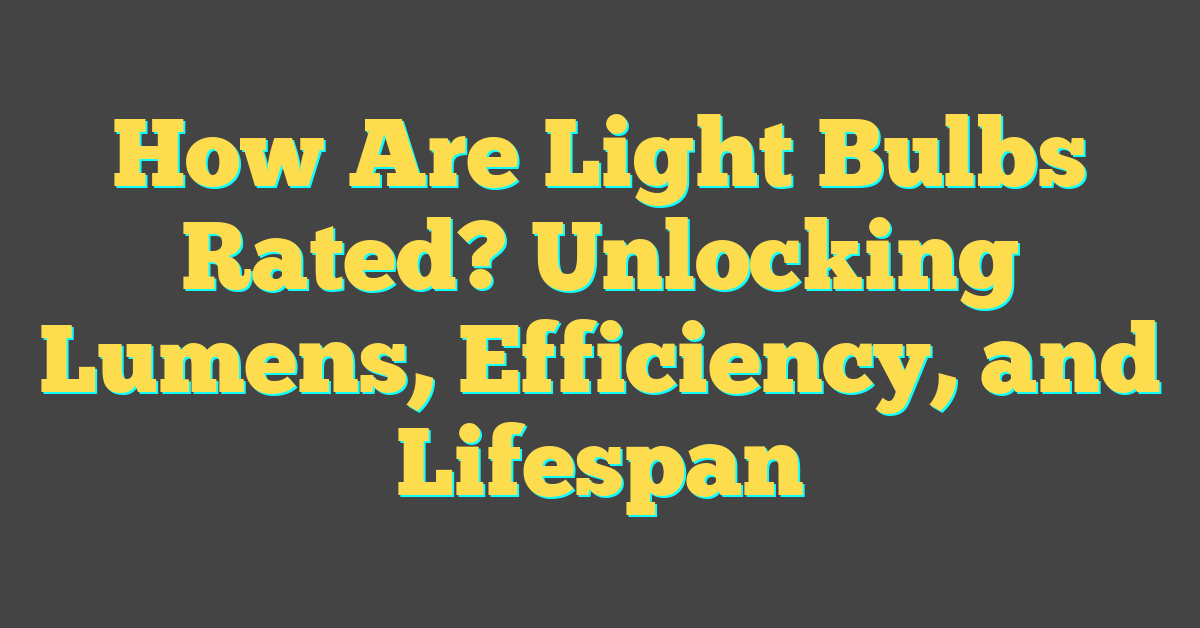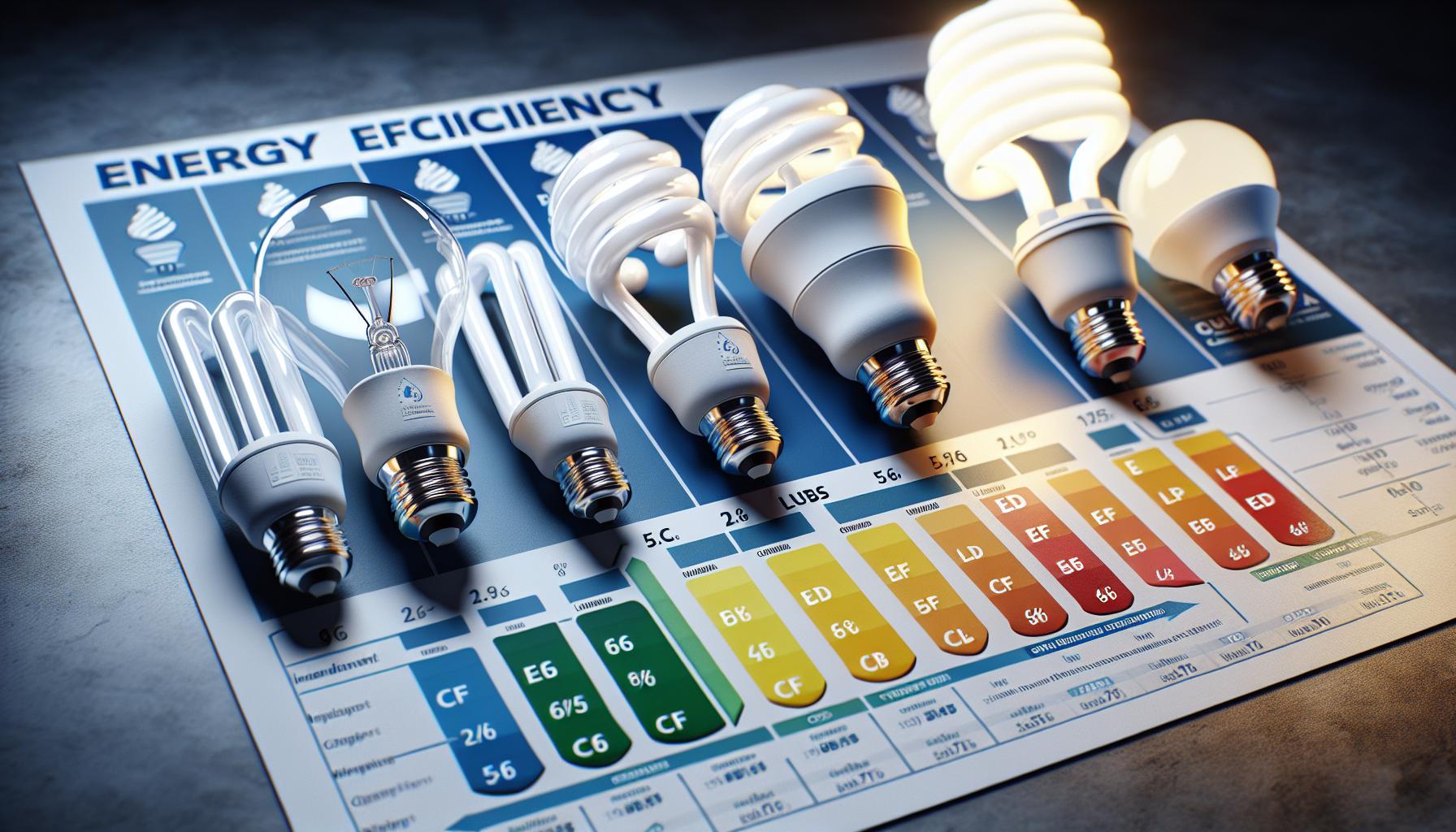Ever wondered what those numbers and symbols on light bulb packages mean? You’re not alone. Navigating the lighting aisle can be like trying to crack an ancient code. But don’t worry, you’re about to become a light bulb rating whiz.

From watts to lumens, and everything in between, these ratings tell a story of how your light bulb will perform. Think of them as a cheat sheet to finding the perfect bulb for your space. Let’s shed some light on the subject and make your next bulb purchase a breeze.
The Basics of Light Bulb Ratings
Before diving into the numbers game, let’s cover the basic terms that’ll pop up on any light bulb packaging. First off, there’s lumens – your go-to measure for brightness. The higher the lumens, the brighter the bulb. Think of lumens as the amount of light you’re getting from the bulb. Rather than focusing solely on watts, which indicate energy consumption, lumens give you the real scoop on light output.
Next up, wattage. It’s no longer about how much energy a bulb uses. For years, you might’ve correlated watts directly with brightness, but today, it’s all about efficiency. With LED and CFL technology, fewer watts can mean just as much light. This means you’ll save energy and have brilliant lighting!
Color temperature is gauged in Kelvins and it influences the mood of your space. Those numbers can make your room feel like a cozy cabin or a clean, crisp office. Lower Kelvin degrees mean a warm, yellowish hue, great for living rooms or bedrooms, while higher numbers offer a cooler, bluer light, perfect for task lighting in kitchens and bathrooms.
And don’t overlook the Color Rendering Index (CRI). Sitting on a scale from 0-100, this number measures how true to life colors appear under a bulb’s light. The closer to 100, the more vibrant and true your reds will look, and the greener your greens will appear.
Here’s a quick reference table to help you out:
| Term | Useful For | Ideal Range |
|---|---|---|
| Lumens | Judging brightness | 800-1100 (for most rooms) |
| Wattage | Calculating energy efficiency | The lower the better for energy savings |
| Color Temperature | Setting the mood of a space | 2700-6500 Kelvin |
| CRI | Assessing color accuracy | 80-100 for vibrant colors |
Armed with this knowledge, you’re well on your way to making an informed decision about which light bulb is best for your needs. Remember, a little understanding goes a long way in transforming your space with just the right light.
Understanding Watts, Lumens, and More

When you’re knee-deep in a DIY home lighting project, it pays to know your stuff. Wattage is an old favorite; it’s how you’ve historically gauged light bulbs. However, it measures energy use, not brightness. Now, here’s a twist: modern LED bulbs use far fewer watts for the same amount of light. So, what’s a better brightness gauge? Lumens. With lumens, you directly measure the brightness regardless of the bulb’s energy consumption.
Let’s talk about those lumens. Picture a cozy room lit just to your liking – that’s your lumen goal. For instance, a reading light typically ranges from 400 to 1,000 lumens. When you’re hosting a lively dinner party, though, you’ll need more punch – think 1,000 to 2,000 lumens. It’s all about matching lumens to the mood and use of your space.
But brightness isn’t the whole picture. Color temperature impacts the vibe too. Measured in Kelvins (K), it can change a room from a warm, inviting space to a cool, energizing one. Lower color temperatures create a warm, amber light, while higher temperatures give off a cool, bluer light. It’s not just about the looks; the right color temperature can also affect your mood and circadian rhythms.
Here’s a quick tip: aim for 2,700 to 3,000 K for your living room and bedrooms where you seek warmth and relaxation. Your kitchen and workspaces can do with a crisper 3,500 to 5,000 K, keeping you alert and focused.
Lastly, the Color Rendering Index (CRI) plays a silent role in your bulb’s performance, ranking how colors look under the artificial light compared to natural light. A high CRI value, closer to 100, means you’re seeing everything in its truest form – an absolute must for those who crave authenticity in color, whether in art spaces, closets, or kitchens.
| Term | Ideal Range |
|---|---|
| Lumens (Brightness) | Varies based on room use and preference |
| Color Temperature | 2,700 to 3,000 K for relaxation, 3,500 to 5,000 K for workspaces |
Choosing the Right Brightness for Your Space

« How Many Light Bulbs Are There in the United States? Shocking Numbers Revealed
Do Light Bulbs Make Noise? Uncover the Surprising Truth »
When you’re sprucing up your home, the right lighting can transform a room from drab to fab. Imagine flipping a switch and everything—your walls, décor, and furniture—just pops! That’s the magic of picking the perfect brightness. So, how do you nail it every time? Let’s break it down.
Think of lumens as your go-to metric for brightness. More lumens mean more light. Simple, right? But here’s where it gets a bit more nuanced. Every space in your home has its own vibe and function, necessitating a unique lumen count. For example, kitchens and bathrooms usually need brighter lights, pushing higher on the lumen scale. You’re chopping veggies or lining your eyes—you need to see clearly!
Here’s a quick peek at recommended lumen ranges for different spaces:
| Room | Lumens |
|---|---|
| Kitchens | 3,000 – 8,000 |
| Bathrooms | 4,000 – 8,000 |
| Bedrooms | 2,000 – 4,000 |
| Living Rooms | 1,500 – 3,000 |
| Dining Areas | 3,000 – 6,000 |
| Home Offices | 3,000 – 6,000 |
But don’t just think numbers, think layers. Overhead lighting is great but don’t forget accent and task lighting. Mix floor lamps, table lamps, and spotlights to create layers that enhance the functionality and ambience.
Dimmer switches are your friends. They’re like volume knobs for your lights—crank ’em up or dial ’em down depending on the time of day or the mood you’re in. It’s like having multiple bulbs in one, perfect for adapting to different activities or times of day.
Remember, each bulb’s packaging will list its lumens. Check these before you buy to ensure you’re getting the brightness your space needs. Armed with this knowledge, you’ll be lighting up your home like a pro in no time! And hey, who doesn’t love a beautifully lit room that just feels right? Keep tweaking until it feels like your space is giving you a warm, visual hug.
Decoding Color Temperature and CRI

Now that you’re equipped with the basics of lumens and wattage, let’s dive deeper into what really colors your world – color temperature and the Color Rendering Index (CRI). When you’re selecting light bulbs, these are critical in achieving the ambiance and functionality you’re aiming for in each space.
Color temperature is measured in Kelvin (K), and it influences how warm or cool the light appears. It does not affect the actual temperature of the bulb; it’s purely about aesthetics. Here’s a quick breakdown to guide you:
- Soft White (2700K – 3000K): Ideal for bedrooms and living rooms, these bulbs emit a warm, cozy glow.
- Bright White/Cool White (3500K – 4100K): Great for kitchens, bathrooms, and garages, giving off a more energetic light.
- Daylight (5000K – 6500K): Perfect for task lighting and reading, these bulbs provide a high-contrast, vibrant light.
Think about the mood you want to create. A lower Kelvin number means a warmer, more inviting light, while a higher number gives off a cooler, more alerting effect.
In terms of the Color Rendering Index, or CRI, this measures a light source’s ability to show the true colors of objects compared to natural light. The scale runs from 0 to 100, with natural outdoor light having a CRI of 100. For a room where color distinction is key, like a craft room or where you get dressed, you’ll want a bulb with a CRI closer to 100.
Here’s why CRI matters:
- High CRI lights: Enhance the vibrancy of colors, making them more natural and true to life.
- Lower CRI lights: May cast a dull shade, distorting the true colors and reducing contrast.
When you’re in the aisle wondering how your new sweater or paint color will look at home, remember, a higher CRI bulb in the store means fewer surprises later. It’s essential to balance both color temperature and CRI for each room’s unique needs. Keep adjusting your lighting choices to get that perfect combination that not only lights up your space but also enhances it.
Comparing Energy Efficiency

When you’re on a mission to make your home more efficient, understanding how light bulbs are rated for energy efficiency will be right up your alley. It’s not just about saving money on your power bill; it’s also about reducing your carbon footprint and contributing to a healthier environment. Let’s dive into the nuts and bolts of what makes a light bulb energy-efficient!
First off, look for the lumens-to-watts ratio. Lumens measure the amount of light produced, while watts gauge energy consumption. The higher the lumens-to-watts ratio, the more bang you’re getting for your buck. This means more light with less energy used! Modern LED bulbs shine in this field, often boasting a staggeringly efficient ratio compared to older incandescent bulbs.
Another key metric is the bulb’s lifespan. LED bulbs typically outlast their incandescent and fluorescent counterparts dramatically. With lifespans that can stretch into decades, LED bulbs not only cut down on your energy usage but also reduce the frequency of replacements. So, in addition to looking at the immediate energy savings, consider the long-term benefits of extended durability and reduced waste.
Let’s break down some numbers:
| Bulb Type | Average Lifespan (Hours) | Average Lumens | Average Wattage |
|---|---|---|---|
| Incandescent | 1,000 | 800 | 60 |
| CFL | 8,000 | 800 | 14 |
| LED | 25,000 | 800 | 10 |
Energy Star certification is your beacon here, guiding you to bulbs that meet strict efficiency, quality, and lifetime criteria. An Energy Star-rated bulb typically uses about 70-90% less energy than a traditional incandescent, saving you cash and helping Mother Earth breathe easier.
Conclusion
You’ve seen how crucial it is to look beyond the wattage of a bulb to its lumens-to-watts ratio for a true measure of efficiency. You’re now aware that LED bulbs not only shine brighter on this scale but also boast a longevity that outshines traditional options. Remember, the presence of an Energy Star label is your shortcut to finding top-performing bulbs. By choosing wisely, you’re not just cutting down on your energy bills—you’re also contributing to a healthier planet. It’s a bright decision all around!
Frequently Asked Questions
What is the significance of the lumens-to-watts ratio in light bulbs?
The lumens-to-watts ratio indicates the efficiency of a light bulb by showing how much light it produces (lumens) per unit of energy consumed (watts). A higher ratio means more light output for less energy, making it a key factor when choosing energy-efficient bulbs.
Why are LED bulbs considered more efficient?
LED bulbs are considered more efficient because they have a high lumens-to-watts ratio, providing more light while using less power. They also have a longer lifespan, reducing the need for frequent replacements.
How long do LED bulbs typically last compared to incandescent and fluorescent bulbs?
LED bulbs typically last much longer than incandescent and fluorescent bulbs. While the lifespan can vary, LED bulbs often last tens of thousands of hours, which can be many times longer than traditional bulb types.
What is the Energy Star certification, and why is it important?
The Energy Star certification is a symbol that indicates a product meets strict energy efficiency guidelines set by the U.S. Environmental Protection Agency. Choosing bulbs with this certification ensures you are getting one of the most energy-efficient options available.
How do energy-efficient bulbs benefit me financially and environmentally?
Energy-efficient bulbs, like LEDs with high lumens-to-watts ratios and Energy Star certification, use less power, leading to lower electricity bills. Less energy consumption also means reduced greenhouse gas emissions, which is beneficial for the environment.




